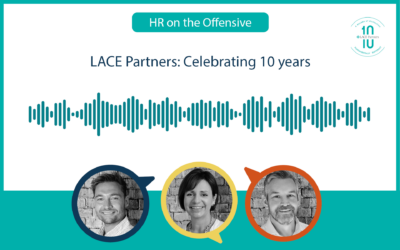As we ended 2021 the big talking point was the impact of the post pandemic ‘Great Resignation’, where the economy opened back up and employees began reconsidering their own career prospects. In 2022 the focus has been on ‘quiet quitting’, so we caught up with Cathy Acratopulo to talk about the impact it has on businesses. So, what is quiet quitting, is it just a short-term reaction to the instability caused post pandemic, or a longer-term trend? Read on for a deep dive or listen to our HR on the Offensive podcast here.
What is the quiet quitting phenomenon?
To me it’s about someone having an attitude or mindset change. Someone hasn’t fully checked out of the organisation, but they’ve decide there not going to go above and beyond anymore, so in other words “I’m going to do what I need to do my job, but little more” i.e., the basics, working just the standard hours – working to rule. This differs for everyone based on the nature of the work they do, where they work, how standard the hours are, etc. It is potentially difficult to identify and that is a challenge many businesses may have already faced, but ultimately it is about the mindset shift of saying “I am going to change my perspective on what I come to work for and how much effort I’m going to put in”.
Why has there been this evolution between people wanting to fully quit their jobs and passive employees?
The impact of COVID impact still lingers within the world of work. We have heard of people expressing burnout, of wanting to focus on work-life balance, personal wellbeing, etc. We’ve also seen and heard many stories in which the increased prevalence of hybrid working leads to higher levels of burnout because it is harder to separate work from your personal life. Post pandemic there has been that focus on wellbeing – be it financial or otherwise – but we’ve also seen the impact of the external market. We have near full employment and the number of vacancies is higher than the number of applicants; which puts more control and power in the hands of employees/candidates. With that choice comes the ability to assess what an individual really wants to do if they are not fully engaged in the work they are doing. There is then this limbo period where employees may take their foot of the gas and not spend 100% of their time focused on their job – ‘quietly quitting’.
Employers therefore have two options:
- Lean in and do something about somebody quiet quitting – Importantly, if you face up to this approach it could result in that member of staff leaving. The talent market is so hot and filling roles is such a challenge, the risk of an employer is that you do not get somebody who can do the job as well as that person who is less engaged and ‘checking out’. But is it better to have an employee who is only putting 50% effort in?
- Look to address the root cause of the problem and get that employee re-engaged – This can be done by investigating what the possible reasons are for the lack of engagement. Is your employee value proposition lacking? Do that individual’s values no longer align with your business? The root cause of why the change in mindset and output has occurred will vary per individual. There will be plenty of situations where individuals can be turned around again and so as an employer the most important thing you can do is communicate and seek that feedback to try to find out why a person has the reduced engagement with the business. In some instances it could be completely out of the control of the organisation; if something has happened outside of work in somebody’s personal life, how much impact can a business have?
Actively listening to employees, trying to understand the root cause, is fundamental if you want to rescue somebody back from quietly quitting.
How much impact does culture have on quiet quitting?
The culture of an organisation invariably has some level of impact on somebody looking to quietly quit. An individual that is fully engaged in the mission, vision and values of an organisation they really believe in is likely to have a high level of job satisfaction. If they understand what the company wants to achieve and feel supported and recognised for their contribution, perhaps with a great line manager around them, they will have less of a desire to ‘quietly quit’. If you are happy in what you are doing and your work life has purpose and meaning, why would you wish to change that?
Of course, there are also circumstances in which it is external factors outside of the control of the business (problems in personal life, etc) that may not be within a business’s control. But what a business can control is what happens within its own walls and culture is a big part of that.
What more can HR do?
Culture is crucial and HR can have an important role to play in helping a business recognise the importance of it. Particularly, HR has a role to play in helping to scope and shape the value proposition a business offers its employees (EVP). AT LACE we call it ‘the deal’ and it is what the organisation offers its employees (and future employees in the shape of candidates). If you suspect your employee is quiet quitting it may indicate that in their eyes, you are not holding up your side of the deal. Are the promises you make being kept and is the business continuing to deliver on its values? If an organisation has shifted fundamentally, then you can understand an individual re-evaluating their situation, deciding they’re going to ‘quietly quit’, and not put the effort in because they don’t believe in what the business is doing.
Ultimately, HR’s role is looking at the catalysts for quiet quitting in their organisation, understanding causes of low engagement and productivity so they can tackle issues at the source.
Having a robust listening function that is timely and organic is important, as we’ve already mentioned. Although running an engagement survey once a year may not help find root causes, it’s essential to deal with cases of ‘quiet quitting’ immediately. Recognising the effects commercially, individually and on the broader workforce is important. You then need to weigh these up against a hot talent market and guide the business, ensuring that risks like ‘quietly quitting’ employees are mitigated as much as possible. Finally, these responsibilities don’t need just completely fall on HR’s shoulders. There is a big element in ensuring line mangers have the ability to spot, understand and respond to team members that are in this situation which I personally feel is a primary responsibility of HR to ensure they have the capability and confidence to people manage effectively.
If you’d like to talk about your approach to your EVP, how you can drive better line management capability, or any elements relating to your people strategy, complete the form below and reach out to us.






